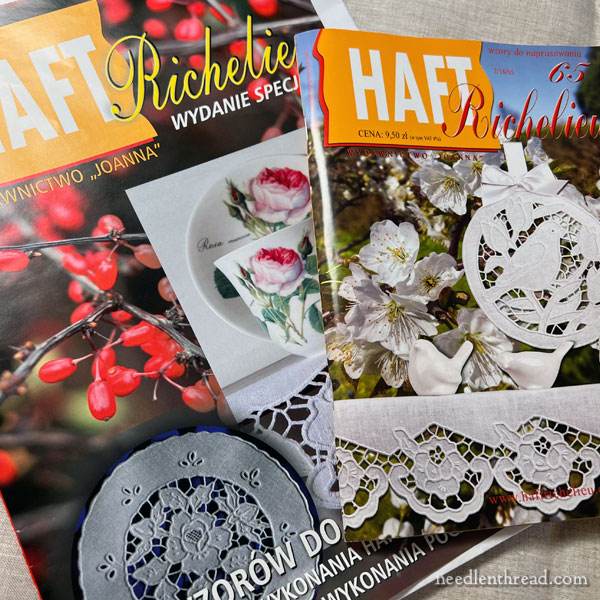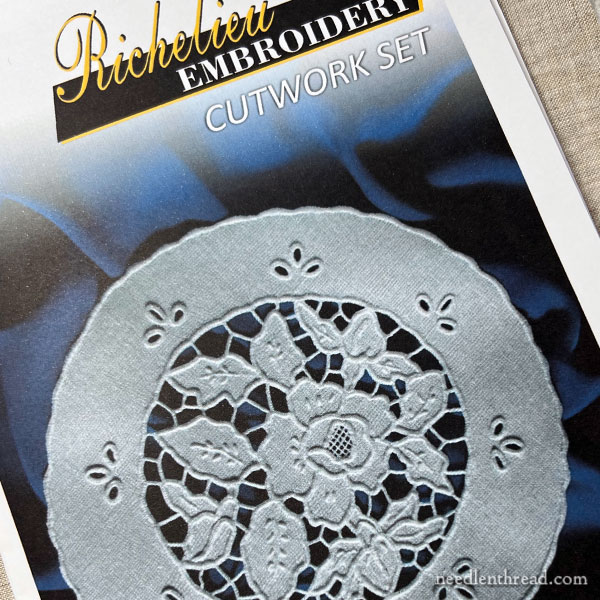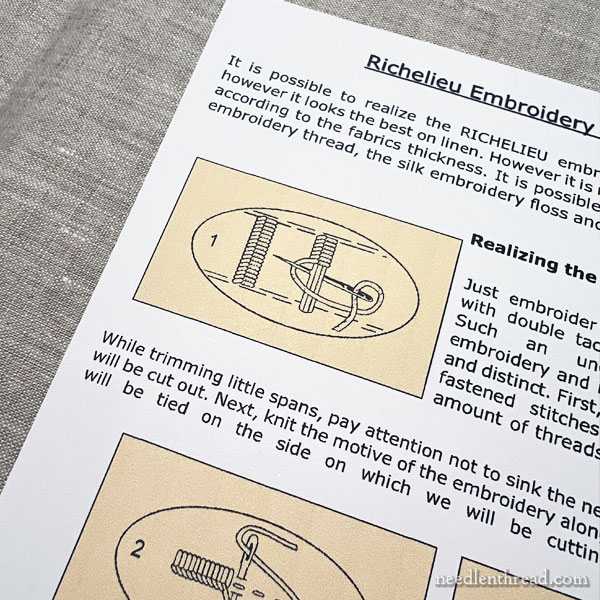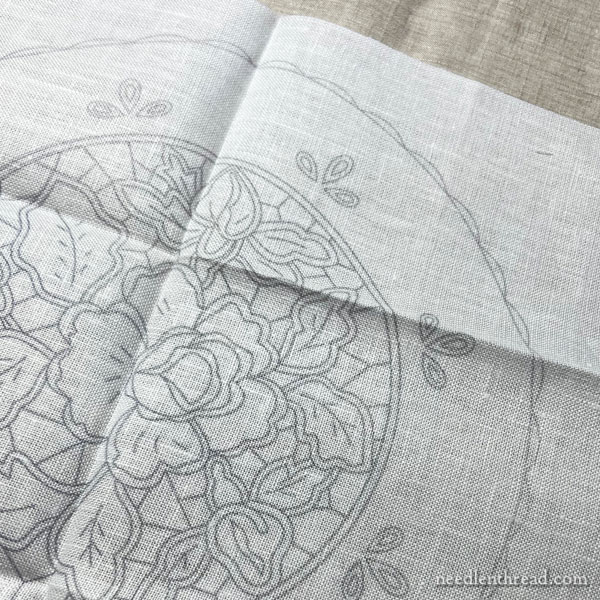A long, long time ago, I wrote about the Richelieu embroidery design booklets produced by Joanna Jakuszewska in Poland.
When it comes to new designs for Richelieu, Joanna is an excellent source. While cutwork is a gorgeous, and relatively simple-in-concept, whitework technique, it is not necessarily as easily accessible, design-wise, as other techniques. Because it’s a small niche under the greater whitework umbrella, it can sometimes be hard to find contemporary designs.
Today, I’ll introduce you to Joanna’s latest venture, since she is no longer publishing the Haft booklets, and talk a little bit about why I’m revisiting cutwork right now.

The Haft booklets were (and are, if you have them) a treasure trove of small to large cutwork designs as iron-on transfers.
Inside each booklet, aside from the iron-on transfers for each design set, are pictures of the complete whitework pieces, plus some minimal text and diagrams to demonstrate how this form of whitework embroidery is accomplished.

Lately, Joanna has moved away from publishing her designs in these booklets with the transfers.
Instead, she is selling ready-to-stitch linen with the design already transferred on it, out of her Etsy shop, KiziMizi Studio.

Inside each partial kit, you’ll find instructions for working the embroidery, along with clear diagrams.
The instructions, if you’re in the US, are in English, and they are simple and clear.

The other part of the kit is the ready-to-stitch linen. The design is clearly transferred onto a medium-weight Polish linen.
There are no threads included in the kits, but this is understandable. It makes more sense financially to source threads where you live. In the US, cutwork thread (coton a broder) is available in four sizes: 16, 20, 25, and 30. Once upon a time, I preferred 40, but alas…
Joanna notes in her instructions that you can use embroidery cotton (this would likely be coton a broder), perle cotton, or regular floss.
To work a piece like this from the kit, since I prefer to work in a hoop, I would probably add a little extra scrap fabric around the linen to extend it to comfortably fit a hoop or frame.
These pre-printed, ready-to-stitch linens with instructions are an affordable way to try your hand a beautiful whitework technique! If you are wanting to try a new skill, and if the pristine world of whitework appeals to you, this is a great way to give it a try!
You can find a whole array of Joanna’s kits ready to go, here in her shop. The designs ship from Poland, but they don’t take too long in the scheme of things!
Why Cutwork?
So, why am I exploring cutwork right now? I’m helping to prepare some new altar cloths for a new church, and I volunteered to help instruct on cutwork locally to assist with the preparation of the cloths.
I don’t suspect I will actually be embroidering any of them myself due to time constraints – I have a different custom job for the same church – but I’m really happy to be helping with some of the preparation.
Joanna very graciously sent along some of her booklets that feature cutwork edges. We’ll probably use one of her designs, and oh glory! The fact that they are iron-ons and ready to transfer expedites the whole entire process. Hurray!
That’s on the plate at the moment! I’ll probably share more on this project off and on. In the meantime, though, I thought that you might like a source for nice, ready-to-stitch cutwork projects, especially if you’ve been wanting to try cutwork, but weren’t sure where to start. It’s always nice to have the transfer work already done for you!
Today, I’ll be photographing my “Christmas break project” so I can show you progress on something that’s been ongoing here for a couple years now… and will likely be ongoing for a couple more. Yes, hexies! I’ll give you an update on that crazy project just around the bend.







From what I see on the photos, to be strict on the definitions, these are renaissance embroidery because there aren’t any pivots on the bars. The Richelieu have picots on the bars while Renaissance embroidery do not have any.
Do you think that using floche would be a nice option to cotton à broder?
Hi, Louise – she does include picots on some of the cutwork. Most of the booklets, I think, have instructions for the picots.
I think floche is a little too soft for cutwork, personally. 🙂
Dear Mary
Joanna Jakuszewska is so talented I really like her work and wish I could do cutwork I have only briefly tried without success. I always find satin stitch difficult when embroidering circles I just can’t get the stitch to bond together like it should. I have had some success in the past but I do find it difficult, would love to be able to learn to stitch cutwork. Her etsy site is lovely and full of beautiful designs well worth a look. Such a shame Haft doesn’t exist anymore. Thank you for sharing with us Joanna’s cutwork and for letting us know of her etsy site lovely designs.
Regards Anita Simmance
I hadn’t realised how much Richelieu work resembled carrickmacross lace, which I used to do, as being a needle as opposed to bobbin lace. I don’t much like the result of bobbin lace these days. I must look again at my lacework books.
Happy New Year, Mary!!
I just ordered a kit from Joanna. Although I bought some of her pamphlets when visiting Poland, I never stitched the designs. The kit is just what I need to get started on this type of embroidery.
I’m really looking forward to seeing your ecclesiastical project progress this year. I know it will be beautiful.
Did I miss a post about your “stitching a row a day” project you started last year? I’ve been curious about an update!
Heh heh. I’m going to get to that! It fizzled about halfway through the year. I picked it up now and then, but never “caught up” – I’m going to continue with it this year, but I’m not sure about committing to a specific daily amount. My life never quite works out that way. 🙂
Hi Mary, what type of linen does she use? I have your white linen sample collection and wondered if I like this technique if there is one of those samples that would be good for this. I also wondered if you have any books you recommend for this technique? Thanks!
Hi, Kirin – Joanna uses a linen that I think is probably made in Poland (that’s where she’s located). I am using the castor sugar linen from the sample pack for working a sample of this type of embroidery, and the cloth that we will be making will be probably made out of the castor sugar in that sample pack. It’s just an excellent quality linen, and I like the weight of it and the “hand” (the surface feel) for this type of work.
I am looking for cutwork tablecloth kits. I had one a long time ago but can’t find any now.
Do you know where I can find one?
I would check out this Etsy shop: https://www.etsy.com/shop/KIZIMIZIstudio. I don’t know if she has full table cloths, but she might be able to put together a custom kit for you? It would be worth reaching out!